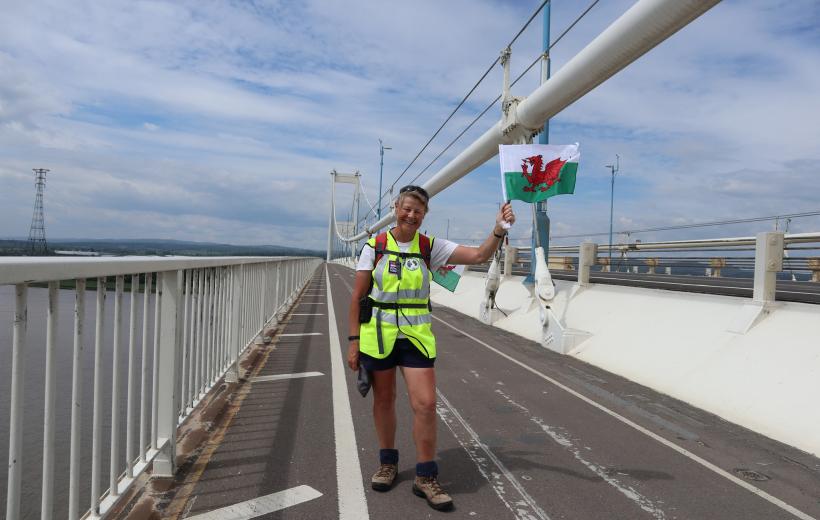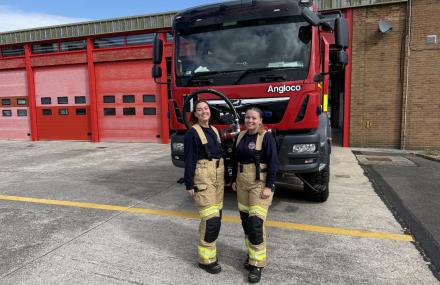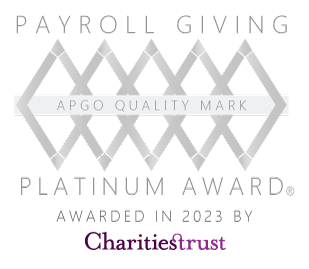The final Welsh leg of Jane's travels took her through some of the great coal exporting ports of Wales, starting with Barry, followed by Penarth, Cardiff and Newport.
"No journey would have been complete without a circumnavigation of Barry Island, once home to a vast Butlins holiday camp until its 30-year life ended in 1996. Today, a new housing development has replaced the former camp buildings. Of course, its funfair, beach and numerous cafes survive and were doing a brisk trade when I passed through – but I avoided temptation!
By now Flat Holm and Steep Holm, two nearby islands in the Bristol Channel, were my constant companions as I headed around Lavernock Point towards Penarth. Lavernock Point and Flat Holm helped make history in 1897, when Marconi first achieved transmitting radio signals between these two places, across a small stretch of open sea. A week later he repeated the experiment, again from Lavernock, but this time across the Bristol Channel to Brean Down in Somerset. A plaque at nearby Lavernock church commemorates this piece of history.
Penarth, although another dock town and at that time still separate from Cardiff, managed to remain a more ‘exclusive’ resort than Barry Island. Grand houses overlooking the Severn estuary were built above the town by wealthy businessmen. Below, a fine pier with a pavilion was constructed which, in the past decade, has undergone extensive restoration and now looks very smart.
Today Penarth is connected to Cardiff by the Cardiff Barrage, another impressive piece of engineering which created a vast freshwater lake by sealing off the estuary of the Taff and Ely rivers from the sea beyond. This visionary idea helped rejuvenate some of the disused dock areas, although Cardiff does still have a modern dock complex where containers have replaced coal. My subsequent afternoon walk around this area of security fences and industrial estates was not an enjoyable one.
Around Cardiff’s revitalised waterfront an eclectic mix of buildings can be found: the old docks’ Pierhead Building; the Senedd, home of the National Assembly of Wales; an old Norwegian Church (now an arts centre) where the best-selling author Roald Dahl was baptised; the former BBC Dr Who Experience building; and the Millenium Centre which is home to Wales’ national orchestra and opera.
Before being rewarded with my Severn Crossing, I had to negotiate the wriggly river Usk that cuts through Newport. Another town that flourished with coal exports, but one that also had a manufacturing and engineering heritage. My route across the river was to be via the Transporter Bridge, similar to the one I used in Middlesbrough when crossing the Tees.
Newport’s Transporter is the oldest and largest of the three transporter bridges that remain in Britain and was designed with extra height to ensure shipping could pass underneath, whatever the state of the tide. Unlike my Middlesbrough journey when I was transported across in a gondola slung under the structure, my Newport journey was somewhat different.
With Newport’s gondola currently undergoing repairs, I took the high route with Rob, the Supervisor, who kindly agreed to escort me across the upper open-grilled walkway. My journey began with a climb of 270 steps to reach the gantry platform, 180 feet above the muddy river. Thereafter, a dizzying walk of 200 yards across the Usk, before I descended 270 steps to the far riverbank. I’d some great views but if you suffer from acrophobia, then this trip isn’t for you!
After Newport, my onward journey on grassy sea banks up the Severn reminded me of the endless miles I’d walked in Essex. Cattle and horses grazed on the flat fields and saltmarshes, while in other fields there were carpets of buttercups. Ahead, the Severn’s Second Crossing, officially named the Prince of Wales Bridge, which carries the M4 motorway, grew ever larger. Opened in 1996, the bridge roughly follows the same line of the Severn railway tunnel which was constructed by the Great Western Railway over 100 years earlier. Rail travel under the Severn, or ferries across the River were the only means of crossing this vast estuary, until the first Severn Road Bridge was opened in 1966 – this was to be my crossing point.
The newer Prince of Wales bridge was built to accommodate the huge increases seen in road traffic since the 1960s. At the time of building it was decided there should be no pedestrian or cycle access, which explains why I crossed on the iconic 1966 structure. After all the delays, setbacks and difficulties experienced during my Welsh trek, it was an exhilarating moment walking out across the River Severn. For once, I’d bright clear skies and good views to accompany me all the way. Magic!
Stepping off the bridge and leaving the South Wales Coast Path behind me, I immediately joined the Severn Way. This led me down the east side of the Severn towards the vast industrial and port areas of Avonmouth and the Royal Portbury Dock. It was grim walking and a case of just ‘sticking at it’ as lorries and trucks thundered by, raising kerbside dust in all directions. Before heading up and over the foot and cycle path running parallel to an incredibly busy M5/Avonmouth bridge, I had an important date to keep.
Before Avonmouth, I broke my journey at Severn Beach to meet a lively 95 year-old WWII telegraphist Wren. It was an uplifting experience meeting Connie who is full of fun and still drives a car. My Support Team had to prise her out of the Victory Van’s driver’s seat! When I arrived, Connie handed me a bottle of Prosecco to celebrate my arrival back in England. Thereafter she serenaded me with her high-tech keyboard while I enjoyed a refreshing drink. I couldn’t think of a better way to end my 722-mile Welsh odyssey."
To donate to Jane's fundraising page please visit: https://uk.virginmoneygiving.com/victorywalk17-18










